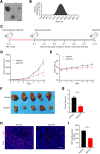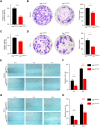Extracellular Vesicles from Akkermansia muciniphila Elicit Antitumor Immunity Against Prostate Cancer via Modulation of CD8+ T Cells and Macrophages
- PMID: 33907401
- PMCID: PMC8068512
- DOI: 10.2147/IJN.S304515
Extracellular Vesicles from Akkermansia muciniphila Elicit Antitumor Immunity Against Prostate Cancer via Modulation of CD8+ T Cells and Macrophages
Abstract
Purpose: Prostate cancer (PCa) is one of the most common malignancies in males. Despite the success of immunotherapy in many malignant cancers, strategies are still needed to improve therapeutic efficacy in PCa. This study aimed to investigate the effects of Akkermansia muciniphila-derived extracellular vesicles (Akk-EVs) on PCa and elucidate the underlying immune-related mechanism.
Methods: Akk-EVs were isolated by ultracentrifugation and intravenously injected to treat syngeneic PCa-bearing immune-competent mice. Immunophenotypic changes in immune cells, such as cytotoxic T lymphocytes and macrophages, were measured via flow cytometry analysis. Histological examination was used to detect morphological changes in major organs after Akk-EVs treatments. In vitro, flow cytometry was performed to confirm the effects of Akk-EVs on the activation of CD8+ T cells. Quantitative PCR and immunofluorescence staining were carried out to test the impact of Akk-EVs on macrophage polarization. Cell counting kit-8 (CCK-8) analysis, colony formation assays, and scratch wound healing assays were conducted to assess the effects of Akk-EVs-treated macrophages on the proliferation and invasion of PCa cells. CCK-8 assays also confirmed the impact of Akk-EVs on the viability of normal cells.
Results: Intravenous injection of Akk-EVs in immune-competent mice reduced the tumor burden of PCa without inducing obvious toxicity in normal tissues. This treatment elevated the proportion of granzyme B-positive (GZMB+) and interferon γ-positive (IFN-γ+) lymphocytes in CD8+ T cells and caused macrophage recruitment, with increased tumor-killing M1 macrophages and decreased immunosuppressive M2 macrophages. In vitro, Akk-EVs increased the number of GZMB+CD8+ and IFN-γ+CD8+ T cells and M1-like macrophages. In addition, conditioned medium from Akk-EVs-treated macrophages suppressed the proliferation and invasion of prostate cells. Furthermore, the effective dose of Akk-EVs was well-tolerated in normal cells.
Conclusion: Our study revealed the promising prospects of Akk-EVs as an efficient and biocompatible immunotherapeutic agent for PCa treatment.
Keywords: Akkermansia muciniphila; cytotoxic T lymphocytes; extracellular vesicles; immunotherapy; macrophages; prostate cancer.
© 2021 Luo et al.
Conflict of interest statement
The authors report no conflicts of interest in this work.
Figures





Similar articles
-
Akkermansia muciniphila-derived extracellular vesicles mitigate smoking-induced prostate inflammation and fibrosis.Int Immunopharmacol. 2025 Mar 6;149:114195. doi: 10.1016/j.intimp.2025.114195. Epub 2025 Feb 3. Int Immunopharmacol. 2025. PMID: 39904036
-
Amuc_1434 From Akkermansia muciniphila Enhances CD8+ T Cell-Mediated Anti-Tumor Immunity by Suppressing PD-L1 in Colorectal Cancer.FASEB J. 2025 Apr 30;39(8):e70540. doi: 10.1096/fj.202403295RR. FASEB J. 2025. PMID: 40231387
-
Akkermansia muciniphila outer membrane protein regulates recruitment of CD8+ T cells in lung adenocarcinoma and through JAK-STAT signalling pathway.Microb Biotechnol. 2024 Jul;17(7):e14522. doi: 10.1111/1751-7915.14522. Microb Biotechnol. 2024. PMID: 39016683 Free PMC article.
-
Immune Cell-Derived Extracellular Vesicles - New Strategies in Cancer Immunotherapy.Front Immunol. 2021 Dec 8;12:771551. doi: 10.3389/fimmu.2021.771551. eCollection 2021. Front Immunol. 2021. PMID: 34956197 Free PMC article. Review.
-
Professional killers: The role of extracellular vesicles in the reciprocal interactions between natural killer, CD8+ cytotoxic T-cells and tumour cells.J Extracell Vesicles. 2021 Apr;10(6):e12075. doi: 10.1002/jev2.12075. Epub 2021 Apr 1. J Extracell Vesicles. 2021. PMID: 33815694 Free PMC article. Review.
Cited by
-
The emerging role of bacterial extracellular vesicles in human cancers.J Extracell Vesicles. 2024 Oct;13(10):e12521. doi: 10.1002/jev2.12521. J Extracell Vesicles. 2024. PMID: 39377479 Free PMC article. Review.
-
Native and Engineered Probiotics: Promising Agents against Related Systemic and Intestinal Diseases.Int J Mol Sci. 2022 Jan 6;23(2):594. doi: 10.3390/ijms23020594. Int J Mol Sci. 2022. PMID: 35054790 Free PMC article. Review.
-
Targeted editing of CCL5 with CRISPR-Cas9 nanoparticles enhances breast cancer immunotherapy.Apoptosis. 2025 Apr;30(3-4):912-935. doi: 10.1007/s10495-024-02032-6. Epub 2025 Jan 27. Apoptosis. 2025. PMID: 39870938 Free PMC article.
-
Oral Pathobiont-Derived Outer Membrane Vesicles in the Oral-Gut Axis.Int J Mol Sci. 2024 Oct 17;25(20):11141. doi: 10.3390/ijms252011141. Int J Mol Sci. 2024. PMID: 39456922 Free PMC article. Review.
-
Diet-driven differential response of Akkermansia muciniphila modulates pathogen susceptibility.bioRxiv [Preprint]. 2023 Dec 15:2023.12.15.571894. doi: 10.1101/2023.12.15.571894. bioRxiv. 2023. Update in: Mol Syst Biol. 2024 Jun;20(6):596-625. doi: 10.1038/s44320-024-00036-7. PMID: 38168188 Free PMC article. Updated. Preprint.
References
MeSH terms
Substances
Supplementary concepts
LinkOut - more resources
Full Text Sources
Other Literature Sources
Medical
Molecular Biology Databases
Research Materials

